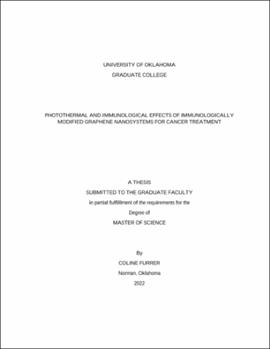| dc.contributor.advisor | Chen, Wei R. | |
| dc.contributor.author | Furrer, Coline L. | |
| dc.date.accessioned | 2022-07-27T14:24:46Z | |
| dc.date.available | 2022-07-27T14:24:46Z | |
| dc.date.issued | 2022-08-04 | |
| dc.identifier.uri | https://hdl.handle.net/11244/335967 | |
| dc.description.abstract | Graphene oxide (GO) has been shown as a potential nanoadjuvant for biomedical applications. Particularly, the capability of GO in loading different therapeutic agents and in absorbing light of a broad wavelength range make GO an ideal nanoplatform for drug delivery and selective phototherapy. Chitosan (CS) is a naturally occurring compound with strong immunological stimulating effects. N-dihydrogalactochitosan, also referred to as glycated chitosan (GC), is an innovative and effective immunostimulant/adjuvant that further enhances the immunostimulatory and surfactant properties of CS. In this study, both CS and GC were used to functionalize GO to improve its biocompatibility and improve its immune-stimulating effect for cancer treatment. This work was designed to determine the main properties of GO/CS and GO/GC nanoparticles (NPs), when used in near-infrared photothermal therapy (PTT) for laser-initiated immunotherapy for cancer treatment. GO/CS and GO/GC NPs were synthesized by self-assembling in an aqueous solution via electrostatic interactions. GC allows for better dispersion and stabilization of NPs than CS. Compared with GO, GO/CS and GO/GC had bigger sizes and positive surface charges. GO showed high thermal conversion ability when irradiated with a near-infrared laser. In vitro studies were conducted to determine the effects of GO/CS + PTT and GO/GC + PTT on target pancreatic and melanoma tumor cells. Free GO was toxic to the cells whereas GO/CS and GO/GC showed limited cytotoxicity. The combination of NPs with PTT caused significant tumor cell death due to the GO-enhanced laser light absorption. Dendritic cells and macrophages were stimulated in vitro to investigate the potential of the NPs as immune-stimulating agents in inducing the secretion of the pro-inflammatory cytokines IL-6 and TNF-alpha. The responses of the immune cells to GC and GO were evaluated by phenotyping the surface markers by flow cytometry. Overall, GO/CS and GO/GC showed promising properties as stable, safe, and effective photothermal agents and immunostimulants for nano-ablative immunotherapy for cancer. Future in vitro and in vivo studies will be conducted to further understand the effects of GO/CS and GO/GC as nanostimulants/adjuvants for cancer treatment and vaccination. This and future work will lay the foundation for future clinical applications of these novel nanosystems.
Keywords: graphene oxide (GO); chitosan (CS); N-dihydrogalactochitosan (glycated chitosan, GC); immunostimulant; laser immunotherapy (LIT); thermal effect; cell death. | en_US |
| dc.language | en_US | en_US |
| dc.subject | Combinational therapy for cancer treatment | en_US |
| dc.subject | Nano-ablative photoimmunotherapy | en_US |
| dc.subject | Laser immunotherapy | en_US |
| dc.title | Photothermal and immunological effects of immunologically modified graphene nanosystems for cancer treatment | en_US |
| dc.contributor.committeeMember | Clegg, John | |
| dc.contributor.committeeMember | Wilhelm, Stefan | |
| dc.date.manuscript | 2022-07-22 | |
| dc.thesis.degree | Master of Science | en_US |
| ou.group | Gallogly College of Engineering::Stephenson School of Biomedical Engineering | en_US |
